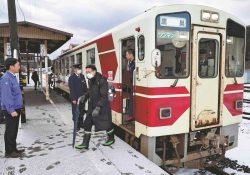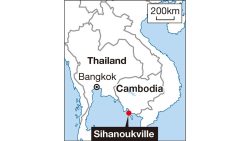
A memorial for Turkish American activist Aysenur Eygi at the site where she was shot dead near Beita.
17:16 JST, September 12, 2024
BEITA, West Bank – It was Aysenur Eygi’s first time at a West Bank demonstration, and she was nervous.
The 26-year-old Turkish American told fellow activists she hoped to be a “protective presence” for Palestinians at a time of spiraling violence across the Israeli-occupied territory.
“We had both decided we did not want to be near any action at all,” said Helen, a volunteer from Australia in her early 60s who was with Eygi throughout the day.
Eygi’s caution did not protect her. She was fatally shot in the head on Sept. 6 in the village of Beita, near Nablus, following brief clashes after Friday prayers. The Israel Defense Forces said Tuesday it was “very likely” she had been hit “unintentionally” by one of its soldiers. “The incident took place during a violent riot,” the statement said, and the fire was aimed at “the key instigator.”
But a Washington Post investigation has found that Eygi was shot more than a half-hour after the height of confrontations in Beita, and some 20 minutes after protesters had moved down the main road – more than 200 yards away from Israeli forces. A Palestinian teenager, who witnesses say was standing about 20 yards from Eygi, was wounded by Israeli fire; the IDF would not say if he was a target.
Citing an ongoing investigation, the IDF also declined to answer questions from The Post about why its forces fired toward the demonstrators so long after they had retreated, and from a distance where they posed no apparent threat.
To reconstruct the day’s events, The Post spoke to 13 eyewitnesses and Beita residents and reviewed more than 50 videos and photos provided exclusively by the International Solidarity Movement, the organization Eygi was volunteering with, and Faz3a, another Palestinian advocacy group. Some foreign activists spoke on the condition they be identified by their first name, or on the condition of anonymity, for fear of Israeli reprisals, including being barred from reentering the country.
On Wednesday, President Joe Biden called Eygi’s death “totally unacceptable,” adding that Israel’s “preliminary investigation has indicated that it was the result of a tragic error resulting from an unnecessary escalation.” On Tuesday, Secretary of State Antony Blinken called on Israeli security forces to make “fundamental changes” in the way they operate in the West Bank, including to their rules of engagement.
The military’s rules of engagement in the West Bank are confidential, but Israeli rights groups have tried for years to shed light on them. Joel Carmel, the advocacy director of Breaking the Silence, an organization of IDF veterans that collects extensive testimonies from current and former troops, said soldiers and junior commanders are given broad latitude to open fire, including based on speculation about future threats posed by alleged suspects. During some protests, testifiers have said that shots to the legs of “central instigators” are deemed acceptable to deter other demonstrators, according to Carmel.
Since 2021, the IDF has killed 15 Palestinians during demonstrations in Beita, according to Faz3a and Hisham Dweikat, a local resident and member of the Palestinian National Council. Last month, another American citizen, Daniel Santiago, a 32-year-old teacher from New Jersey, was shot in the thigh by Israeli forces in the same olive grove where Eygi was killed. The IDF said Santiago was “accidentally injured” when soldiers “fired live rounds in the air” to disperse protesters.
Violence has been surging in the West Bank since the Oct. 7 Hamas-led attacks on Israel. At least 634 Palestinians have been killed by Israeli forces over that period, according to the United Nations, whose figures do not distinguish between combatants and civilians. The majority have died in escalating military raids on Palestinian refugee camps where militants hold sway; others have been killed by extremist settlers, or in regular confrontations with soldiers in places like Beita.
“It happens every week: tear gas and live ammunition,” said Santiago. “It could have been me, it could have been others too.”
‘Gunshot!’
On Friday morning, activists said, Eygi and four other volunteers hired a taxi in Ramallah, the de facto Palestinian capital in the West Bank, and drove about 30 miles north to Beita, a familiar flash point.
Palestinians there have been battling for decades to hold off the steady advance of Israeli settlers. In 2021, in violation of international and Israeli law, settlers erected a cluster of homes and caravans on a nearby hilltop that became the Jewish outpost of Evyatar.
Military evacuation orders never stuck. In June, Evyatar was one of five outposts legalized by Israel’s far-right government – part of a sweeping effort led by Bezalel Smotrich, a longtime settler activist who now serves as finance minister, to solidify Israeli control of the West Bank. Palestinian residents hold weekly prayers on the hillside opposite the settlement as an act of symbolic protest.
“The Israeli army started to come to the area on a weekly basis and tried to prevent the Friday prayer several times,” said Dweikat. “They suppress us with tear gas and bullets, but the activities continued.”
Eygi had hoped to “bear witness,” said Helen, the Australian activist, who was assigned as her “buddy” to observe Friday’s demonstration. It was her first West Bank protest, too.
The Friday prayer site – a park with a children’s swing and slide atop a steep hill – was quiet when the international observers arrived. But Israeli soldiers were already positioned along the perimeter, residents and activists said.
Villagers started to gather by foot and by car and mingle with the volunteers.
A British activist recounted talking to Eygi as they eyed the soldiers on the other side of the park’s fence. “‘I’m nervous, because the army’s right there,’” he recalled her saying.
It was a little after 12:30 p.m. when the prayers began. Men lined up in rows. Eygi, sitting off to the side, put her hands up to worship. Videos taken by activists show a serene scene.
As soon as the service ended around 1:05 p.m., the mood shifted, according to videos and eyewitnesses. Older residents drove away. Young men and children took up positions on the road leading down from the park.
It’s unclear how the confrontation began, those present said, but initially it followed the regular rhythm of clashes between heavily armed soldiers and Palestinian protesters. Some threw stones, including with slingshots, while others burned tires on the hillside, photographs show.
Israeli forces used tear gas to disperse the crowd, then resorted almost immediately to live ammunition, residents and activists said.
“The Israeli soldiers were very provocative,” said Jonathan Pollak, a longtime Israeli activist with Faz3a, who frequently attends the Beita demonstrations and was there that day.
Since October, Pollak said the use of live fire has become routine in Beita as the military’s “dispersal means of choice.” The IDF declined to comment on their use of live fire during protests.
Alex Chabbott, another American volunteer with Faz3a, was running late. When he began walking up the hill to the prayer area he pulled out his phone to start filming. It was 1:14 p.m., according to a Post review of the video’s metadata.
“Gas, gas, gas!” someone shouts in a second video he filmed two minutes later. Burning tires are visible in the road.
“The soldiers are just out of sight,” Chabbott, 43, said as he filmed, backing down the hill. He turned to run, then paused not far from a child using a slingshot.
Eygi, shocked by the swift escalation, had already started “back down the road, behind the boys, behind the other volunteers,” Helen said.
Other activists and Palestinians took cover behind trees, rocks and terraces, they said, while others put obstacles at various points down the road, including rocks and a dumpster. Protesters said it was a common tactic used to waylay Israeli troops, who often raid the village after Friday prayers.
A photograph taken at 1:21 p.m. shows at least four Israeli soldiers at the top of the hill. Video and photos from the next several minutes show soldiers taking up positions on higher ground – including on the rooftop of Beita resident Ali Maali’s home, and near a military vehicle.
Maali’s house is built into the slope of the hill. About 80 yards from the prayer site, it offers a clear view of the olive groves below.
Israeli forces frequently commandeer his roof on Fridays, the 44-year-old said, as “it’s a strategic location.” That day, he said, they arrived “immediately after the prayer” and at least four soldiers climbed to the roof. Maali and several others gathered on his veranda below, he said, and tried to stay out of sight.
Helen slipped and fell during “the scary race down the road,” at one point spraining her ankle, she said, but the younger woman stayed with her, “being a protective strength.”
A video filmed at 1:22 p.m. shows the road next to the olive grove. A shot rings out.
“They’re shooting with regular guns!” an activist says off-camera in Japanese. Steven Beck, an audio forensic expert who consulted for the FBI and reviewed the footage for The Post, said the pop heard on the video was consistent with a gunshot – a finding corroborated by a second audio expert, Rob Maher.
A minute later, the British activist called Eygi to check where she was, according to a call log viewed by The Post. Eygi told him she had already made it down the hill to the olive grove.
“Stay there,” he recalls telling her.
Helen positioned herself behind a tree, she said, with Eygi to her left.
The next few minutes were “calm,” she said. “We had a chance to take a deep breath … standing in what we thought was a safe distance.”
A video filmed at 1:29 p.m. shows people loitering at the bottom of the hill; a man stands with his hands on his hips.
“They haven’t shot any more live rounds, no more tear gas, yet,” Chabbott, the American volunteer, says in another video filmed around the same time. For nearly 20 minutes after that, the scene remained relatively calm, Palestinians and volunteers said.
But one of the soldiers on the roof was “training his gun in our direction,” recalled Pollak, who was standing next to a dumpster that had been moved into the middle of the road at the bottom of the hill. He and other activists said he was the closest person to Israeli troops at the time, just over 200 yards away; Eygi was around 30 yards further.
He saw a muzzle flash and heard two shots, he said.
From his veranda, Maali heard a “strong” sound of a gun firing from above, he said, and the impact “shook the house.”
Helen, standing next to Eygi, “heard a large crack sound of live ammunition.”
The moment of the gunshots was not caught on any of the footage reviewed by The Post. There was nothing much happening at the time to film, activists and residents said.
“Some people say there were two shots, some people say they were three,” said Chabbott, who thought he heard one ping off the dumpster in front of him. “It was chaos.”
At 1:48 p.m., he began filming.
“Gunshot!” an unseen woman can be heard screaming in the background. She pleads for an ambulance.
In the olive grove, Helen saw Eygi drop facedown to the ground beside her. The older woman rolled her over. Blood was pouring from the left side of Eygi’s head, she said, and she was unresponsive.
The investigation
The IDF’s initial inquiry into Eygi’s death “found that it is highly likely that she was hit indirectly and unintentionally by IDF fire which was not aimed at her, but aimed at the key instigator of the riot.”
Yet the shots fired toward the activists, including the one that claimed Eygi’s life, came some 20 minutes after they had retreated to the bottom of the hill – more than two football fields away from the nearest Israeli soldiers.
“Even an Olympic stone thrower cannot make half that distance,” Pollak said.
The IDF did not respond to Post questions about the identity of the “instigator,” or why live fire was justified under the circumstances.
The military’s rules of engagement “are an instrument for justifying use of fire rather than a means for controlling it,” said Carmel from Breaking the Silence.
Eran Maoz, 23, who had escaped down the hill with the rest of the crowd, was standing beside a 17 year-old-Palestinian when the shots rang out.
“I saw the boy immediately putting his hand on his stomach,” he said. “I started screaming to the ambulance.”
The Palestinian teenager – who Maoz said was lightly injured by a ricocheting bullet – declined multiple requests to be interviewed via intermediaries, as did his family members.
Maoz doesn’t know if he was hit by a first or second shot, or where exactly the bullet caromed off of – Beita residents said it was likely an electricity pole or the dumpster. It all happened too fast, Maoz said.
And when he realized someone had been more seriously hurt, he ran to the olive grove.
A video he filmed at 1:49 p.m. shows Eygi bleeding and surrounded by paramedics. “Bring a stretcher quickly,” someone cries. “Quickly!” Eygi is lifted into an ambulance.
She was pronounced dead around 2:35 p.m. at Rafidia Hospital, according to director Fouad Nafaa, after multiple attempts at resuscitation.
During her training with ISM, Eygi had spoken about her fear that she “wouldn’t make a difference,” fellow activists said. Her death has now become a test case for U.S.-Israel relations, after 11 months of growing tensions between the two allies over the war in Gaza and Israeli policy in the West Bank.
“The U.S. government has had full access to Israel’s preliminary investigation, and expects continued access as the investigation continues, so that we can have confidence in the result,” Biden said Wednesday.
Eygi’s loved ones say that’s not enough. “Let us be clear, an American citizen was killed by a foreign military in a targeted attack,” the family said in a statement Wednesday. “The appropriate action is for President Biden and Vice President Harris to speak with the family directly, and order an independent, transparent investigation into the killing of Ayşenur, a volunteer for peace.”
"News Services" POPULAR ARTICLE
-

American Playwright Jeremy O. Harris Arrested in Japan on Alleged Drug Smuggling
-

Taiwan President Shows Support for Japan in China Dispute with Sushi Lunch
-

Japan’s Nikkei Stock Average as JGB Yields, Yen Rise on Rate-Hike Bets
-

Japan’s Nikkei Stock Average Licks Wounds after Selloff Sparked by BOJ Hike Bets (UPDATE 1)
-

Japanese Bond Yields Zoom, Stocks Slide as Rate Hike Looms
JN ACCESS RANKING
-

Keidanren Chairman Yoshinobu Tsutsui Visits Kashiwazaki-Kariwa Nuclear Power Plant; Inspects New Emergency Safety System
-

Imports of Rare Earths from China Facing Delays, May Be Caused by Deterioration of Japan-China Relations
-

Japan Exports Rise in October as Slump in U.S. Sales Eases
-

Govt Aims to Expand NISA Program Lineup, Abolish Age Restriction
-

Blanket Eel Trade Restrictions Rejected


























